Globetrotters
Throughout history, individuals have traveled around the world, either voluntarily or in distress, seeking knowledge and bringing it home. Here are stories about seven individuals with different backgrounds who left their mark on society.
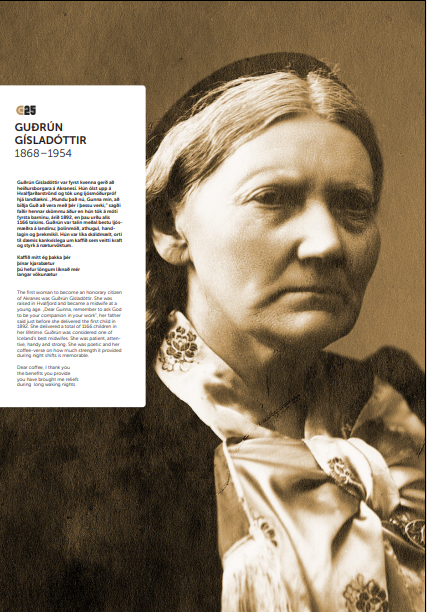
|
Guðrún Gísladóttir (1868 – 1954) Guðrún Gísladóttir was the first woman to be made an honorary citizen of Akranes. She grew up on Hvalfjarðarströnd and was, at a young age, certified as a midwife by the Medical Director of Health. "Now remember, my dear Gunna, to ask God to be with you in this work," said her father in 1892, shortly before she delivered her first child of 1,166. Guðrún was considered one of the best midwives in the country; patient, attentive, dexterous and enduring. She was also a poet and wrote for example this poem about the coffee that provided power and strength during night shifts.
My coffee I thank you your benefits you have long been kind to me long waking nights (it goes witout saying that it reads better in icelandic)
|
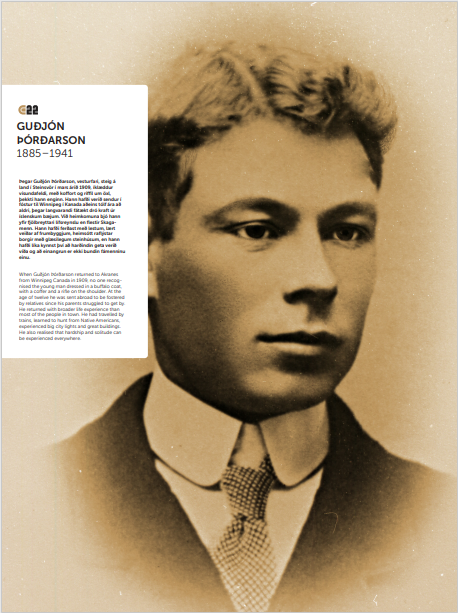
|
Guðjón Þórðarson (1885 – 1941) When Guðjón Þórðarson „vesturfari“ or "west goer" (someone who travelled west to north america), landed in Steinsvör in March 1909, wearing bison fur, with a trunk and a rifle on his shoulder, no one recognized him. He had been sent to foster care in Winnipeg, Canada, at the young age of twelve, when long-term poverty drained the life out of Icelandic towns. When he returned home, he had a more varied life experience than most people from Akranes. He had traveled by train, learned to hunt from the natives, visited electrically lit cities with magnificent stone houses, but he had also learned that hardship can be worldwide and that isolation is not limited to small populations. |
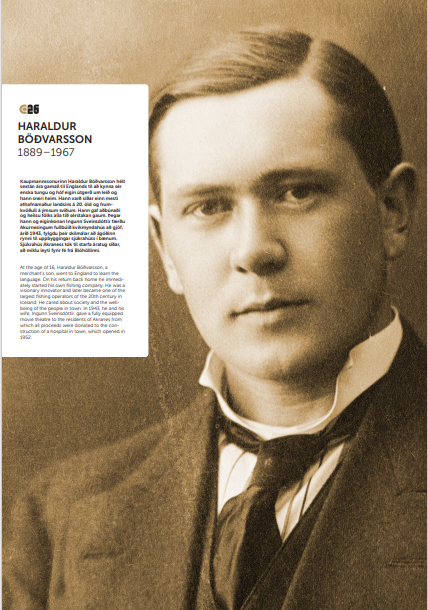
|
Haraldur Böðvarsson (1889 – 1967) The merchant's son, Haraldur Böðvarsson, went to England at the age of sixteen to learn the English language and started his own fishing business as soon as he returned home. He later became one of the country's greatest entrepreneurs of the 20th century and a pioneer in various fields. He always paid special attention to the environment and the health of the people. When he and his wife Ingunn Sveinsdóttir gave the people of Akranes a fully equipped cinema as a gift, in 1943, it came with the condition that the proceeds would go to the construction of a hospital in the town. Akranes Hospital began operations a decade later, largely with funding from the Cinema.
|
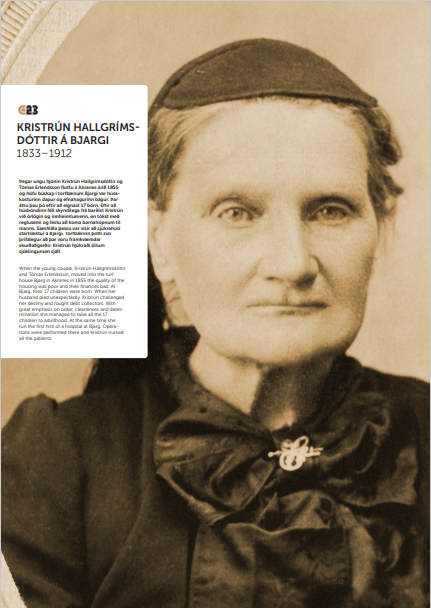
|
Kristrún Hallgrímsdóttir á Bjargi (1833 – 1912) When the young couple Kristrún Hallgrímsdóttir and Tómas Erlendsson moved to Akranes in 1855 and started farming in the turf farm Bjarg, the housing situation was poor and so was the economy. There, however, they were to have 17 children. After Tómas suddenly passed away, Kristrún fought with fate and the debt collectors, but managed with order and determination to bring the group of children to adulthood. At the same time, a hospital of sorts was operated at Bjarg. The turf farm was considered so clean that surgery was performed there. Kristrún nursed all the patients herself. |
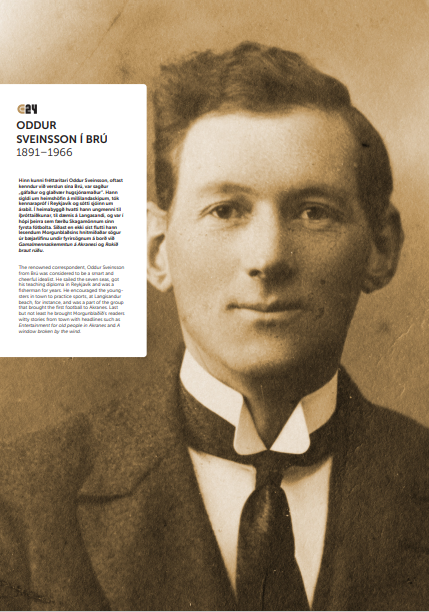
|
Oddur Sveinsson í Brú (1891 – 1966) The well-known reporter Oddur Sveinsson, usually associated with his store Brú, was said to be an "intelligent and cheerful visionary". He sailed the world's oceans on international ships, graduated as a teacher in Reykjavík and visited the sea for years. In his hometown, he encouraged young people to play sports, for example in Langasandur, and was part of the group that brought the people of Akranes ther first football. Last but not least, he told the readers of Morgunblaðið concise stories from town life under headlines such as Senior citizen entertainment in Akranes and The storm broke a window.
|
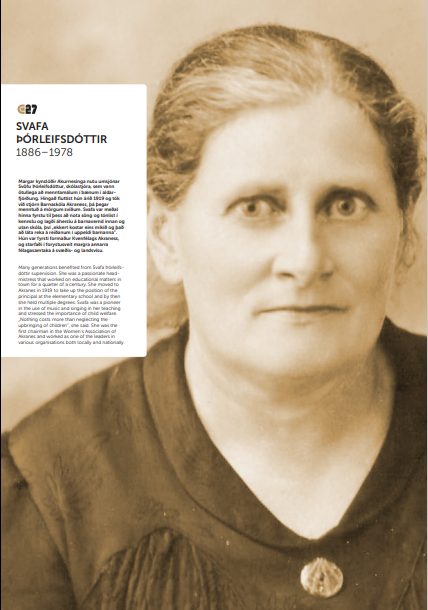
|
Svafa Þórleifsdóttir (1886 – 1978) Many generations of the people of Akurnes were supervised by Svafa Þórleifsdóttir, the school principal, who worked diligently on education in the town for a quarter of a century. She moved here in 1919 and took over the management of The elementary school of Akranes, then already educated in many fields. Svafa was one of the first to use singing and music in teaching and emphasized child protection inside and outside schools, because "nothing is as costly as carelessness when raising children". She was the first chairman of the Women's Association of Akranes, and worked in the leadership of many other associations at the regional and national level. |
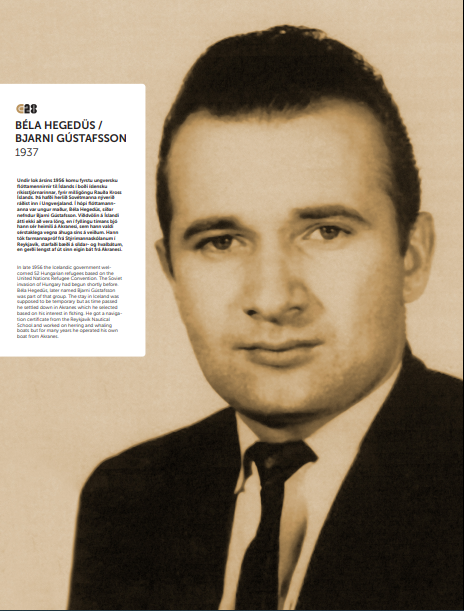
|
Béla Hegedüs / Bjarni Gústafsson (1937) At the end of 1956, the first Hungarian refugees came to Iceland at the invitation of the Icelandic government, through the Icelandic Red Cross. The Soviet army had recently invaded Hungary. Among the refugees was a young man, Béla Hegedüs, later named Bjarni Gústafsson. His stay in Iceland was not supposed to be long, but in due course he built a home in Akranes, which he chose especially because of his interest in fishing. He graduated as a seaman from the Reykjavík Naval Academy, worked on both herring and whale boats, but for the most part he operated his own boat from Akranes.
|